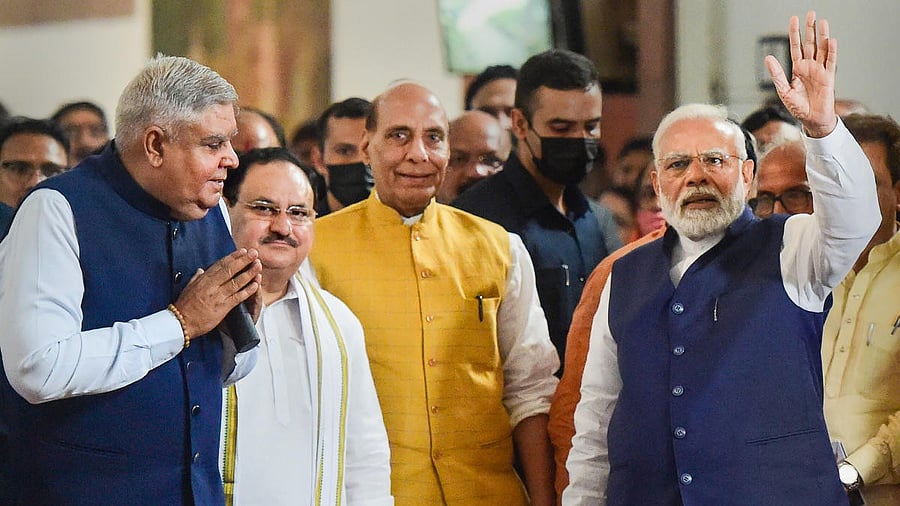
Former Vice President Jagdeep Dhankhar (L) with PM Modi and senior BJP leaders.
Credit: PTI Photo
The office of the vice president holds far less visibility and recognition in India compared to its counterpart in the United States. When framing the Constitution, India’s framers borrowed this institutional feature from the American political system. In the United States, the Constitution assigns two principal functions to the vice president: acting as the immediate successor to the president in case of a vacancy and serving as the presiding officer of the Upper House—the Senate.
Having been ruled under British rule for nearly two and a half centuries, India was unfamiliar with the presidential system. Instead, the framers replaced the monarch with a largely ceremonial, indirectly elected president. The office of the VP was conceived to assist the president and act as the first in line of succession until a new president is elected. During this interim period, the VP officiates as the president with full authority and emoluments.
In contrast, the American vice president automatically succeeds the president in any eventuality and serves the remainder of the term. So far, nine vice presidents have succeeded to the presidency due to the president either dying in office or resigning. Six vice presidents, after completing their terms at various points, have become the president of the US. In India, however, the vice president does not automatically become president. Instead, he enters the office of the president and performs all its duties until a new president is elected. According to the Constitution, this election must take place within six months, during which the Election Commission facilitates the election through a notification involving the elected members of both Houses of Parliament and state legislatures. The framers of the Indian Constitution did not provide for an automatic succession of the vice-president to complete the remaining term as in the US.
The second function envisaged for the vice-president was to act as the presiding officer of the Upper House, similar to the US model. In the US, the vice president serves as the presiding officer of the Senate. The framers of the Indian Constitution adopted this idea, and the Vice-President of India is the ex-officio Chairperson of the Rajya Sabha. Six vice presidents in India have gone on to become presidents after completing their terms. Two of them resigned in order to become the President of India (V V Giri and R Venkatraman), and one of them died in office (Krishan Kant).
In the U.S., the office of the vice president is created to assist the president in a larger presidential system. The president selects his running mate—someone he deems suitable—to contest the election alongside him. If the vice president resigns, the president can nominate a replacement, subject to congressional approval. Election to the office of president and vice president in India is conducted differently and at different times, and the candidates are in no way related to one another.
The Vice-President of India holds office for a term of five years from the date of assuming office, as outlined in Article 67 of the Constitution. However, the office can be vacated earlier through resignation, removal, or death. Article 67(a) explicitly allows for resignation.
According to Article 68 of the Indian Constitution, an election to fill a vacancy in the office of the vice president—caused by death, resignation, removal, or otherwise—shall be held as soon as possible. The elected individual shall hold office for a full term of five years from the date they assume office, subject to the provisions of Article 67. However, no specific timeframe is mentioned for filling the vacancy—only that it should be held “as soon as possible”—which can undermine the significance of the office. In the interim, the Deputy Chairman of the Rajya Sabha presides over its functions.
Having borrowed this concept from the US, we must ask: in the last seventy-five years, have we succeeded in fully realising the functions of the vice president? Ours is not a presidential system, and therefore, the office of the vice president does not enjoy much visibility, especially when the president’s powers in India are constitutional rather than executive. The vice president’s office has remained largely invisible and unrecognised. This is primarily because India has a parliamentary form of government, where the prime minister and his Cabinet are responsible to Parliament—particularly the lower house (Lok Sabha). Thus, both the president and vice-president have limited roles in the Indian Republic.
In contrast, in the U.S., the office has grown in stature and importance along with the history of the American presidency. The President, Vice-President, and Cabinet form the powerful Executive branch of the government. The US vice president is often entrusted with special responsibilities in foreign affairs and is a member of the president’s Cabinet and the National Security Council. In the US, the proximity between the President and Vice-President is so close that it is often said the Vice-President is “only a heartbeat away from the Presidency.”
In the US, the Senate (Upper House) is more powerful than the House of Representatives. Senators are directly elected by the people for a term of six years, and Senate approval is mandatory for all presidential appointments. In India, the Rajya Sabha (Upper House) is less powerful compared to the Lok Sabha, whose members are directly elected by the people. Members of the Rajya Sabha are not directly elected, and although their term is also six years, the presiding officer (Vice-President of India) wields less power than the Speaker of the Lok Sabha—unlike the US, where it is the opposite.
How can the presiding officer of a powerful House (US Senate) become a less powerful figure when transplanted into a relatively less powerful House (Indian Rajya Sabha)? This irony stands, even though the office was conceived by the framers of our Constitution as a significant one.
(The writer is a senior fellow at LISSTAR, Loyola College (Autonomous), Chennai)